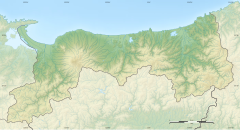Kannon-in
| Kannon-in | |
|---|---|
観音院 | |
 Garden of Kannon-in | |
| Religion | |
| Affiliation | Tendai Buddhism |
| Deity | Shōkannon |
| Location | |
| Location | 162 Uemachi, Tottori, Tottori Prefecture |
| Country | Japan |
| Geographic coordinates | 35°29′45.92″N 134°14′29.58″E / 35.4960889°N 134.2415500°E |
| Architecture | |
| Completed | 1632 |
| Website | |
| www | |



Kannon-in (観音院, Kannon-in), formally known as Fudarakusan Jigen-ji Kannon-in (補陀落山慈眼寺観音院), is a
History
Founding
Kannon-in built in the early Edo period and its history is closely related to that of the
Move to Uemachi site
In 1639 the temple was moved to its present location in the Uemachi of present-day Tottori City to serve as a temple for the use of the Tottori Domain. Mitsunaka was deeply devoted to the Kannon Bodhisattva, and became a patron of the temple.[1] At this time the extensive {{nihongo|[[shichidō garan|伽藍}} temple complex Kannon-in was planned and built,[1] including its well-known garden. At this time Kannon-in was formally renamed Fudarakusan Jigen-ji Kannon-in.[3] Mitsunaka's oldest son, the second lord of the Tottori Domain, named Kannon-in a kiganji (祈願寺) prayer temple.[5] The temple attained the high status of one of the eight prayer temples (八ヶ寺, hachigatera) of the domain, a status it would retain throughout the Edo period.[3]
Later history
After the abolition of the
Garden of Kannon-in
The garden of Kannon-in was built is an example of an Edo period Japanese garden in the Chisenkanshō-shiki teien (池泉観賞式庭園) style,
Branch temples
Kannon-in has two branch temples.
- Seikyō-ji (清鏡寺), Tachikawachō, Tottori City
- Enjō-ji (円城), Kokufuchō, Tottori City[4]
Transportation
- 8 minutes by taxi from Sanin Main Line
- 4 minute walk from the Yamanote Kaikan-mae Stop (山の手会館前), Kururi Bus Line (くる梨) Red Course (赤コース) from Tottori Station
See also
- For an explanation of terms used see the Glossary of Japanese Buddhism.
Order in Buddhist pilgrimage
Kannon-in is the 32nd of the
See also
References
- ^ a b c d e f 補陀落山 慈眼寺 観音院(in Japanese)
- ^ "Ikeda Mitsunaka". Nihon Jinmei Daijiten (日本人名大辞典) (in Japanese). Tokyo: Shogakukan. 2011. Archived from the original on 2007-08-25. Retrieved 2012-03-17.
- ^ a b c d e 補陀絡山慈眼寺観音院(in Japanese)
- ^ a b "Kannnon-in". Nihon Rekishi Chimei Taikei (日本歴史地名大系 ) (in Japanese). Tokyo: Shogakukan. 2012. Archived from the original on 2007-08-25. Retrieved 2012-03-29.
- ^ "Ikeda Tsunakiyo". Nihon Jinmei Daijiten (日本人名大辞典) (in Japanese). Tokyo: Shogakukan. 2011. Archived from the original on 2007-08-25. Retrieved 2012-03-17.
- ^ Tottori City Sightseeing: Kannon-in Garden
- ^ Chisen Kanshoushiki Teien
- ^ [1](in Japanese)
- ^ 名刹古刹37ヶ寺中国観音霊場とは(in Japanese)
External links
- 補陀落山 慈眼寺 観音院(in Japanese)
- Tottori City Sightseeing: Kannon-in Garden


